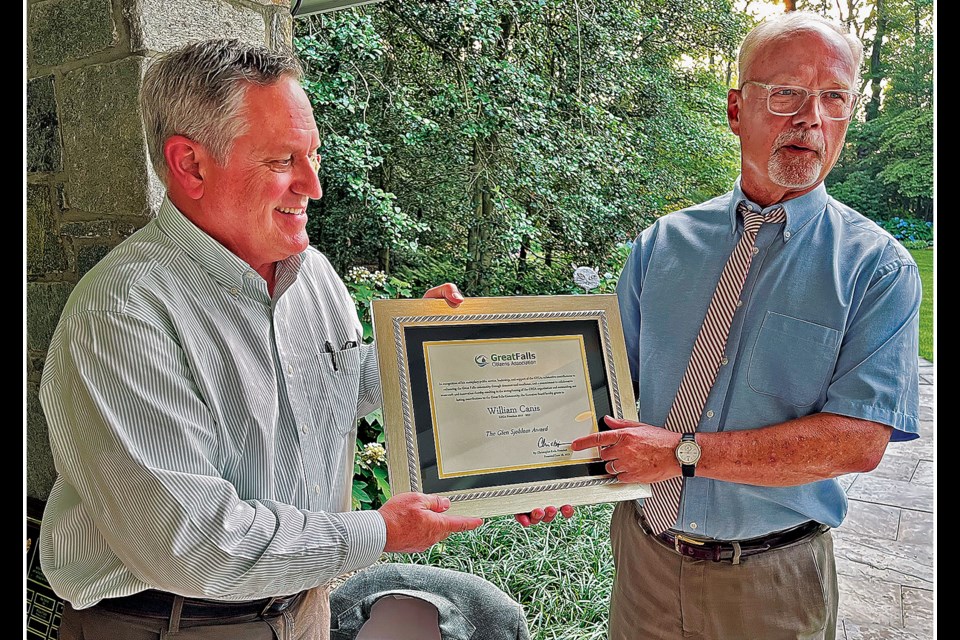For his dedication, doggedness and impressive list of accomplishments, the Great Falls Citizens Association’s executive board on June 28 honored former president William Canis with the group’s top honor, the Glen Sjoblom Award.
Sjoblom, who was among dozens of attendees at the ceremony at the Great Falls residence of Ellen and Allie Ash, told the gathering he had known all 17 GFCA presidents since the association’s founding in 1968, and that Canis had stood out.
“Bill has been the most effective because he doesn’t give up on issues and because he listens to what people say and because he garners the support of his team as well,” Sjoblom said.
Supervisor John Foust (D-Dranesville) read a resolution from the Board of Supervisors honoring Canis for his community contributions.
Canis has “done an outstanding job of leading GFCA through many difficult challenges involving land use, roads and trails, trees, parks and playing fields,” the resolution read.
Canis also played a critical role in trying to preserve the community’s historical assets, including Turner Farm Park, the Grange and Forestville Schoolhouse, according the resolution. He “set a high standard for community leadership,” Foust read.
“You’ve done amazing stuff,” Foust said while shaking hands with Canis. “It’s been a pleasure.”
Canis’ name has been added to the plaque showing winners of the Sjoblom Award, which is on display at Great Falls Library.
“You’ve been involved in everything,” said new GFCA president Christopher Rich. “It’s a tough road for me, I think. I’ve got big shoes to follow.”
Canis “consistently demonstrated sustained leadership, sought innovative solutions, built teams [and] acknowledged leadership of others within our association and our community,” Rich said.
Rich also thanked Canis’ wife, Susan, for “sharing him with us” and gave her a gift certificate to a local restaurant.
Canis, who stepped down earlier this summer after seven years as president, still serves on GFCA’s board. He said he was humbled by the award and the supervisors’ resolution.
“One thing I know is, none of us does these jobs for acclaim,” he said. “We do them because we have a belief and a commitment to some public-policy goal that we’re seeking. We do them for that purpose only. So I do feel a little bit like a duck out of water.”
Pamela Grosvenor, who has known Canis since 2011 and served with him on GFCA’s board, lauded his service.
“I can’t think of anyone who’s been more committed and dedicated to Great Falls than Bill, working tirelessly to advance [initiatives] he feels are important to preserve Great Falls,” she said.
Also in attendance were state Sen. Barbara Favola and Dels. Kathleen Murphy and Rip Sullivan.
Canis and his family moved to Great Falls in 1999 and seven years later he was among a group of people who convinced GFCA leaders to conduct an inventory of big trees in the community. That initiative subsequently won an award from the Fairfax County Tree Commission.
Canis joined GFCA in 2006, worked on its Communications Committee, then co-chaired and later chaired its Environment, Parks and Trails Committee, which tackled the issue of deer overpopulation.
After serving three and a half years as GFCA’s vice president, Canis took over as president in July 2016. During his tenure, the group:
• Established the Great Falls Grange Foundation.
• Supported establishment of the Fairfax County Park Authority’s Resident Curator Program and specifically the curatorship of Sarah Kirk at Turner Farmhouse.
• Established a Schools Committee.
• Strengthened stormwater-retention proffers for the 50-acre Rivermont subdivision.
• Obtained temporary funding, which GFCA hopes eventually will be permanent, for U.S. Park Police to manage traffic near Great Falls Park.
• Began bestowing awards to GFCA members who had made significant contributions to the community.
Sjoblom reflected on how GFCA had changed over the decades.
“In the beginning, it was more an executive action where there would be simple resolutions passed by the membership and then it was up to the leadership of the group to make it happen,” he said.
“We used to do things like deliver position papers to all the supervisors’ homes on Saturday or Sunday to make sure they knew what our issues were,” Sjoblom added. “And we knew all of the Planning Commission members personally. I’m not advocating you do that now.”
To see a video and photos from the proceedings, visit www.youtube.com/watch?v=jleXowzd-Y8.


